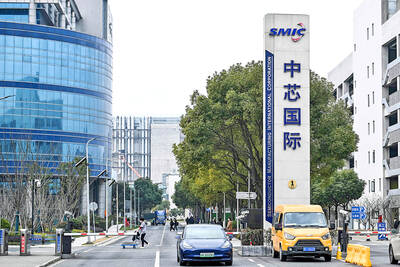Pumped up by persistently high energy prices, the oil industry maintained its streak of massive -- and growing -- quarterly profits this week, aggravating motorists and amazing financial analysts.
"I have been following this industry for 18 years and I have never seen anything like this," Oppenheimer & Co. analyst Fadel Gheit said Friday. "It's like they're printing money."
The results of the world's four largest oil companies illustrate just how well the industry has fared lately. Since the end of 2003, Royal Dutch/Shell Group of Cos, BP Group PLC, Exxon Mobil Corp and ChevronTexaco Corp have earned a combined US$97 billion, including US$23.8 billion during the first three months of this year.
Although crude oil future prices retreated below the important psychological threshold of US$50 per barrel on Friday, Gheit and other industry analysts expect the industry boom to continue, largely because the demand for energy is expected to grow faster than the supply.
"As far as you can look out, things look pretty rosy for [oil] refiners," said Tom Kloza, chief energy analyst for the Oil Price Information Service in Wall, New Jersey.
The bottom line for consumers: US gasoline prices seem likely to stay above US$2 per gallon through the summer -- traditionally the time when more drivers are hitting the road for vacations and burning up more fuel.
Gasoline prices have climbed even higher since the oil industry closed the books on its first quarter, reaching a national average of US$2.28 per gallon for unleaded regular grade earlier this month, according to the daily surveys of the AAA.
The national average stood at US$2.24 per gallon on Friday, a 24 percent increase from US$1.81 at the same time last year, the travel association said. In California and Hawaii, motorists are paying more than US$2.50 per gallon.
Those high prices threaten to cause a backlash against the oil industry because of its "Caligula-like" profits, Kloza said, referring to the decadent reign of a famous Roman emperor.
"It really causes people's blood pressure to rise when they see gas prices going up like they have," Kloza said.
Although the sheer numbers are large, the oil industry's profit margin -- the amount of money pocketed from each sale -- isn't huge.
In the first quarter, the oil and natural gas industry's profit margin averaged 8.5 percent, according to figures compiled by the American Petroleum Institute. The average profit margin for all industries so far is 9.2 percent, according to Business Week's calculations. The figure for all industries is expected to decline as more companies report first-quarter earnings during the next few weeks.
Last year, the profit margin for the oil and natural gas industry averaged 7 percent, slightly below the 7.2 percent average for all industries. Computer software and services had the highest profit margin at 15.6 percent.
"We understand consumers are concerned about gasoline prices, but those are largely a function of the marketplace," said David Fogarty, a spokesman for the Western States Petroleum Association, an industry trade group.
A sharp increase in crude oil prices is the main reason motorists are paying more at the pump.
Analysts also blame an inadequate supply of US oil refineries to quench the country's ever-intensifying thirst for gasoline and heating oil, a problem that's exacerbated whenever a plant curtails production for routine maintenance or other unforeseen circumstances.
President George W. Bush this week suggested building more oil refineries on closed military bases to help increase future production.
Even as the oil industry announced its hefty profits, this week offered motorists some hope for modest price relief at the pumps.
Oil prices have fallen during the past week after Saudi Arabia pledged to increase oil production and a government report of slower US economic growth, a phenomenon that often foreshadows a drop in energy demand.
This week's shift convinced some industry observers that oil prices won't go any higher than they were earlier this month when they soared past US$57 per barrel. "We have broken the back of this bullish market," said Peter Beutel, president of Cameron Hanover Inc., an oil trading advisory firm in New Canaan, Conn.

SEMICONDUCTOR SERVICES: A company executive said that Taiwanese firms must think about how to participate in global supply chains and lift their competitiveness Taiwan Semiconductor Manufacturing Co (TSMC, 台積電) yesterday said it expects to launch its first multifunctional service center in Pingtung County in the middle of 2027, in a bid to foster a resilient high-tech facility construction ecosystem. TSMC broached the idea of creating a center two or three years ago when it started building new manufacturing capacity in the US and Japan, the company said. The center, dubbed an “ecosystem park,” would assist local manufacturing facility construction partners to upgrade their capabilities and secure more deals from other global chipmakers such as Intel Corp, Micron Technology Inc and Infineon Technologies AG, TSMC said. It

People walk past advertising for a Syensqo chip at the Semicon Taiwan exhibition in Taipei yesterday.

NO BREAKTHROUGH? More substantial ‘deliverables,’ such as tariff reductions, would likely be saved for a meeting between Trump and Xi later this year, a trade expert said China launched two probes targeting the US semiconductor sector on Saturday ahead of talks between the two nations in Spain this week on trade, national security and the ownership of social media platform TikTok. China’s Ministry of Commerce announced an anti-dumping investigation into certain analog integrated circuits (ICs) imported from the US. The investigation is to target some commodity interface ICs and gate driver ICs, which are commonly made by US companies such as Texas Instruments Inc and ON Semiconductor Corp. The ministry also announced an anti-discrimination probe into US measures against China’s chip sector. US measures such as export curbs and tariffs

The US on Friday penalized two Chinese firms that acquired US chipmaking equipment for China’s top chipmaker, Semiconductor Manufacturing International Corp (SMIC, 中芯國際), including them among 32 entities that were added to the US Department of Commerce’s restricted trade list, a US government posting showed. Twenty-three of the 32 are in China. GMC Semiconductor Technology (Wuxi) Co (吉姆西半導體科技) and Jicun Semiconductor Technology (Shanghai) Co (吉存半導體科技) were placed on the list, formally known as the Entity List, for acquiring equipment for SMIC Northern Integrated Circuit Manufacturing (Beijing) Corp (中芯北方積體電路) and Semiconductor Manufacturing International (Beijing) Corp (中芯北京), the US Federal Register posting said. The